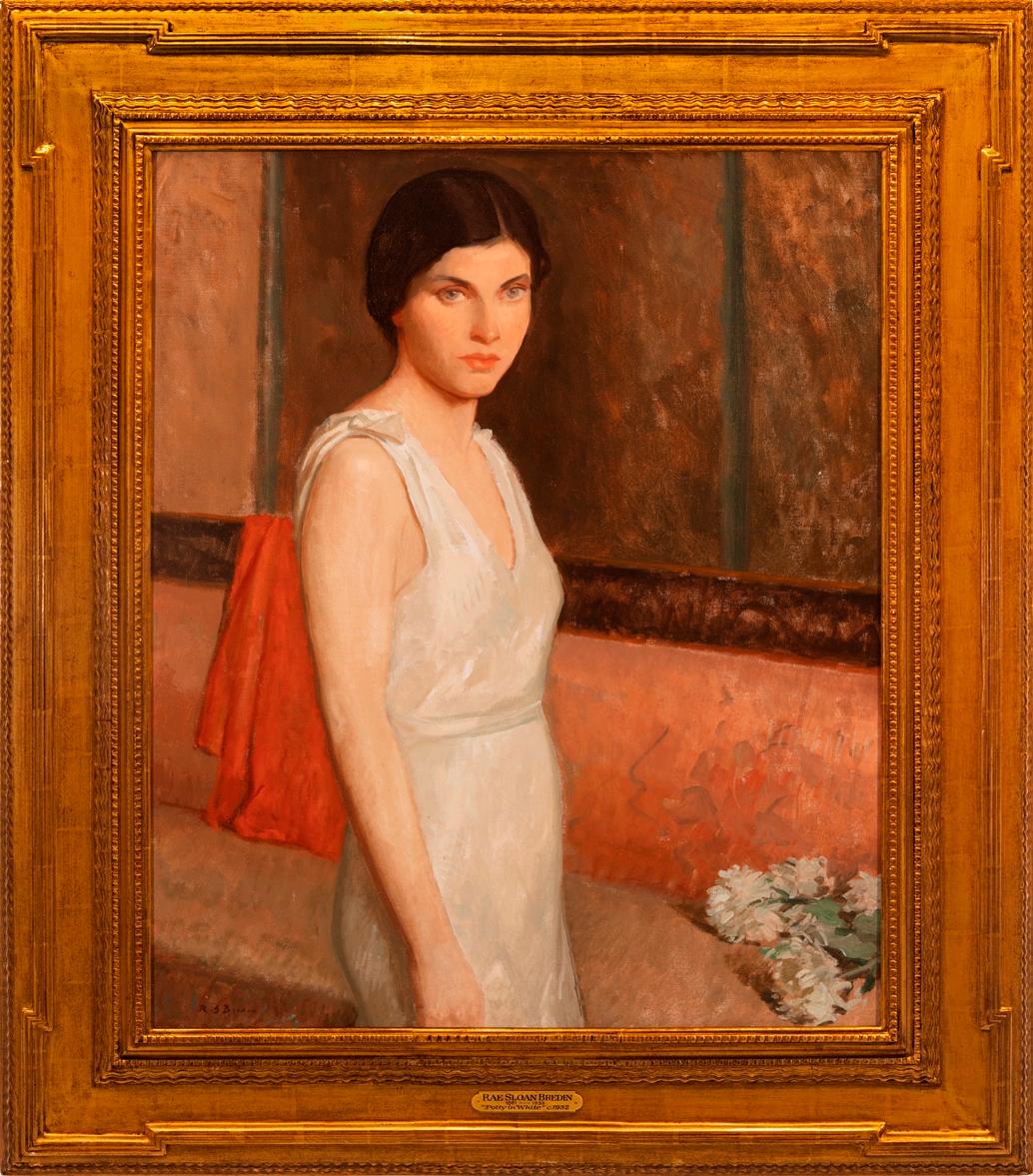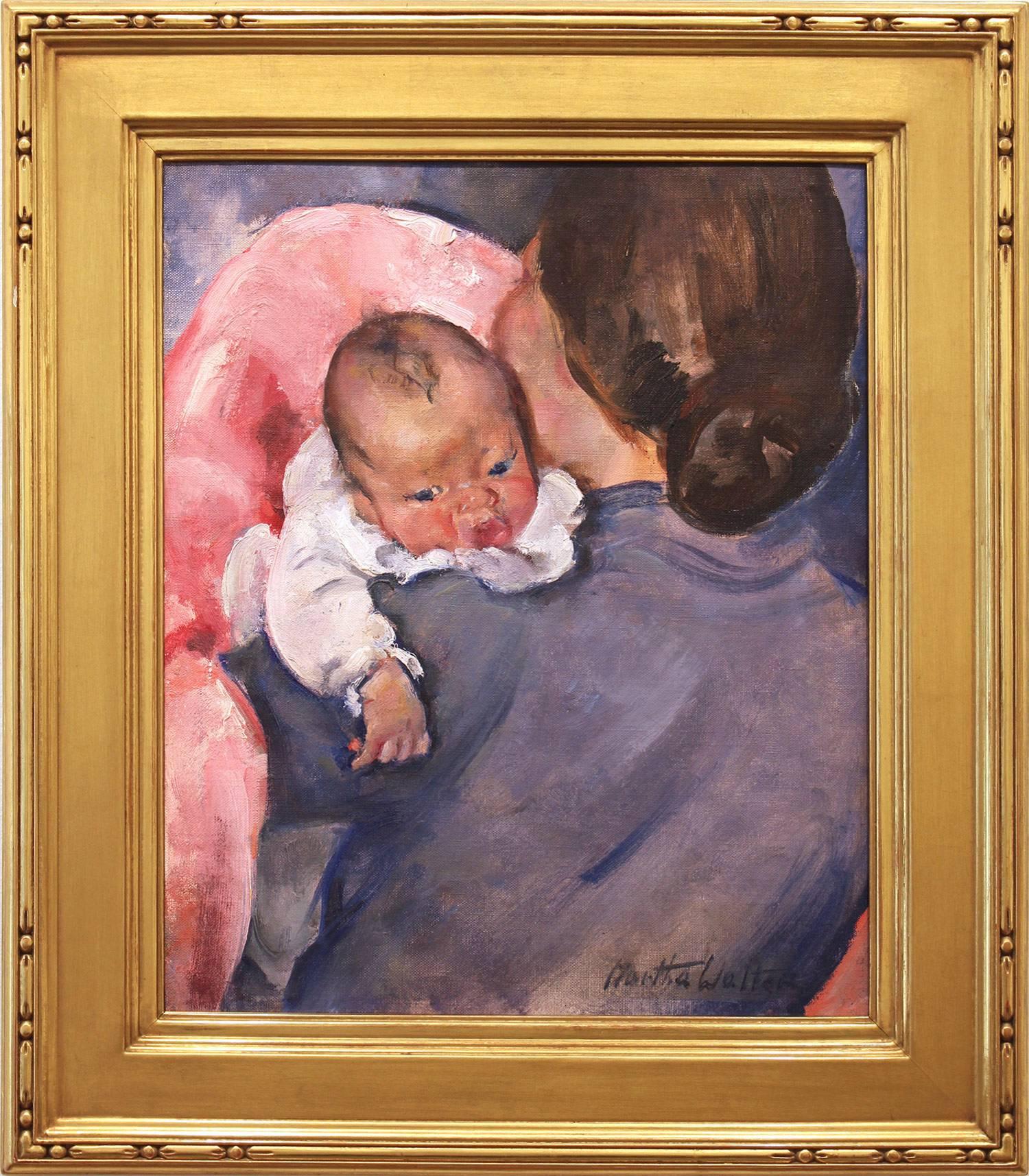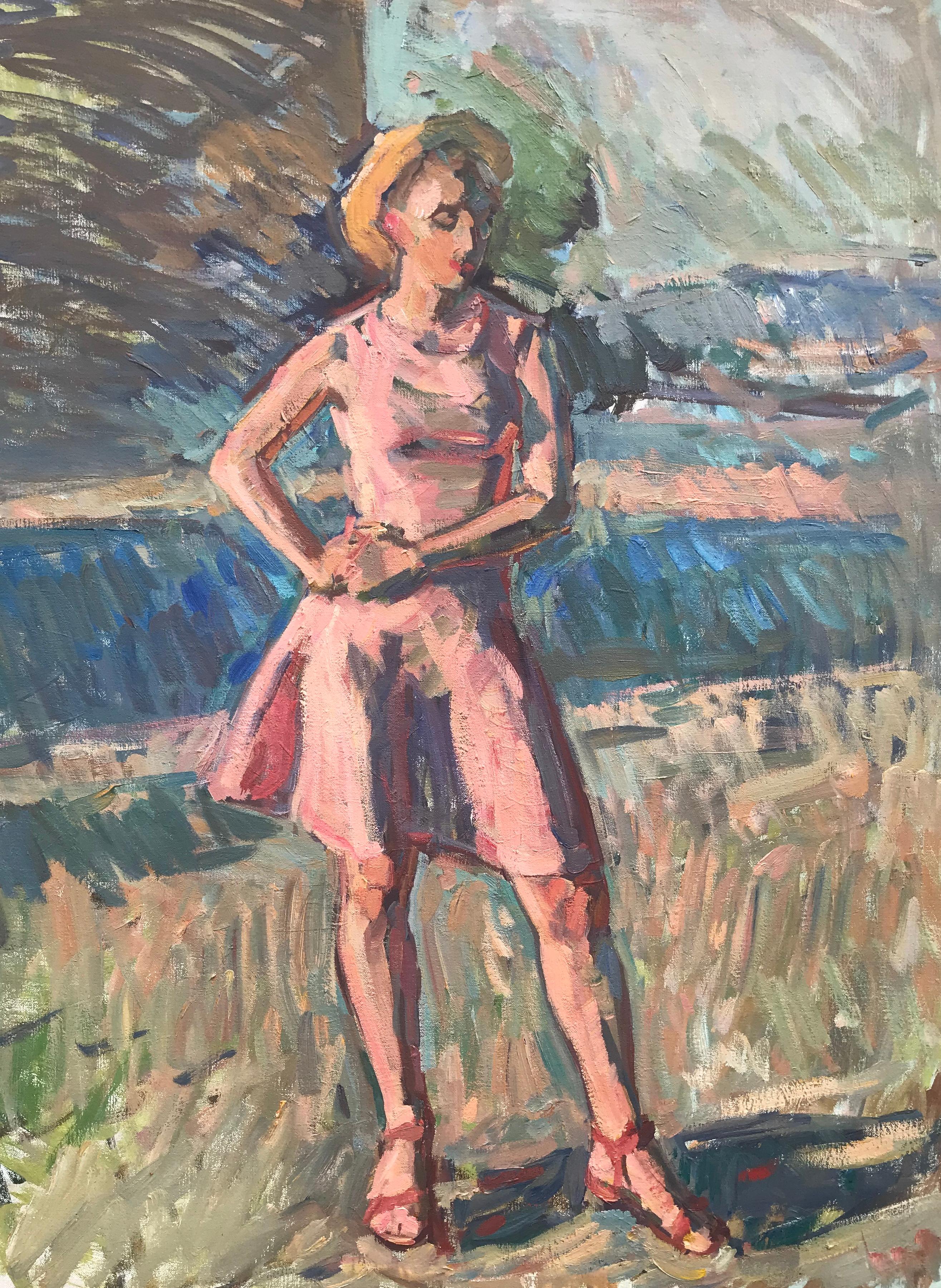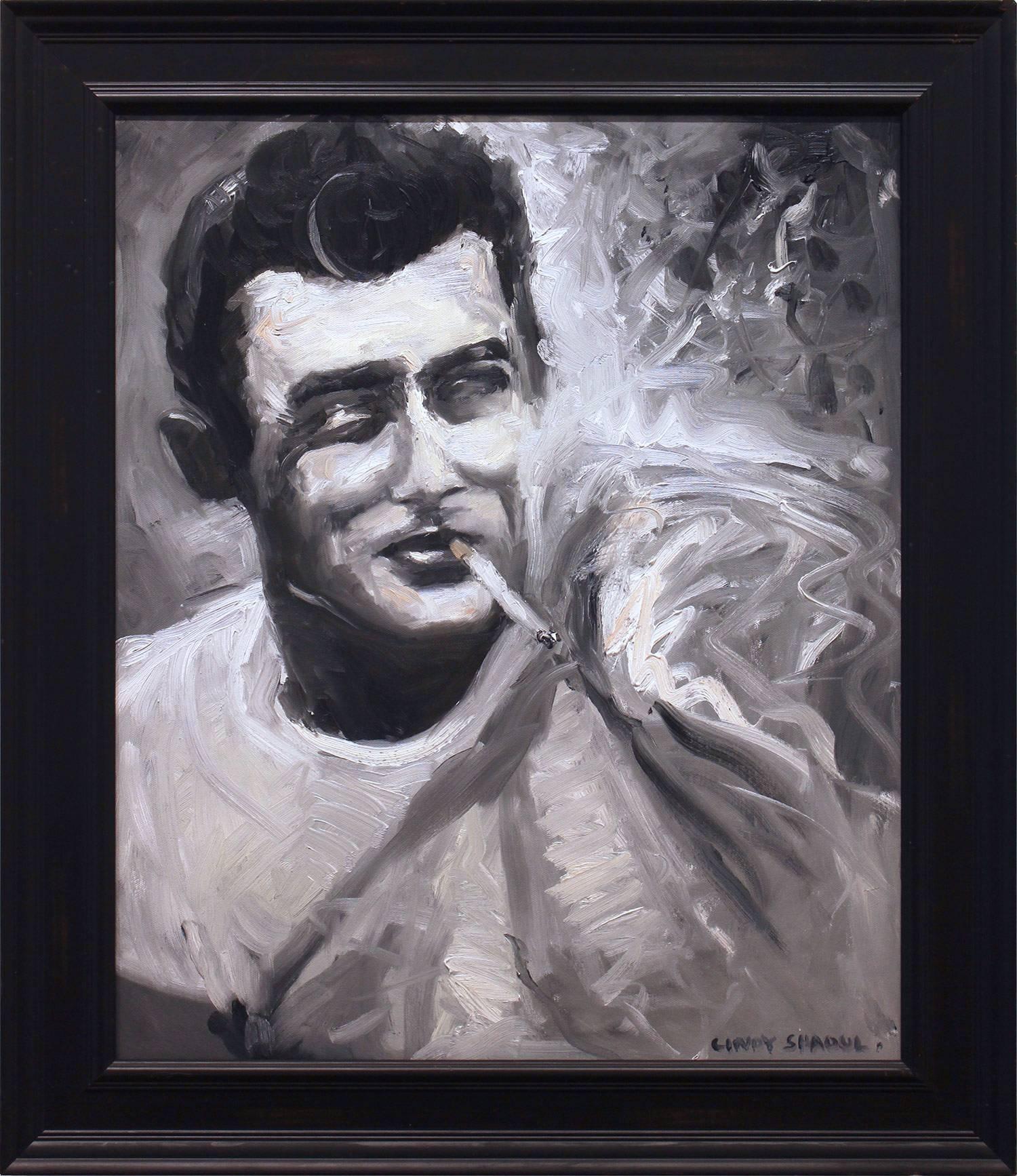Items Similar to "Marion Jones Farquhar" Frederick William Macmonnies, Tennis Olympian Portrait
Want more images or videos?
Request additional images or videos from the seller
1 of 10
Frederick William MacMonnies"Marion Jones Farquhar" Frederick William Macmonnies, Tennis Olympian Portrait1905-11
1905-11
About the Item
Frederick William Macmonnies
Marion Jones Farquhar, 1905-11
Oil on canvas
24 x 20 inches
Provenance:
William Clerk
Private Collection, New York
Literature:
Mary Smart, A Flight with Fame: The Life and Art of Frederick MacMonnies, with a Catalogue Raisonne of Sculpture and a Checklist of Paintings by E. Adina Gordon, Madison, Connecticut, 1996, no. 90.
The work depicts Marion Jones Farquhar who, was an American tennis player who competed during the late 19th century and early 20th century. She won the singles titles at the 1899 and 1902 U.S championships and was the first American woman to medal at the Olympics placing Bronze in singles. Additionally, she was the artist's sister-in-law who often played and competed with MacMonnies in golf and tennis. MacMonnies would often study the movements of her form referenced in his sculpture. When MacMonnies won a doubles golf tournament he said "Marion dragged my dead weight thro' and won us the tournament, showing what great Generalship can do."
A sculptor of classical figures, American-born Frederick MacMonnies had fame in the United States and Europe in the later half of the 19th century and early 20th century. He occasionally returned to America but lived most of his life as in expatriate in France. He was especially known for his lithe bronze figures, especially ones titled Diana. The classical names of these figures allowed him the appearance of propriety but gave him the opportunity to model svelte nudes.
Frederick MacMonnies was one of the first American sculptors to recognize the potential market of the middle class. He copyrighted his works and then contracted with foundries to mass produce some of his figures such as Diana in smaller sizes.
MacMonnies was born in Brooklyn, New York, and was a child prodigy at carving stone. At age 18, he worked in the studio of Augustus Saint-Gaudens, and then persuaded him to become his assistant, keeping models damp and covered, running errands, and cleaning the studio. Evenings he studied at the Art Students League, Cooper Union, and the National Academy of Design.
In Saint-Gaudens' studio, he met many of the wealthy people who shared Saint-Gaudens Beaux-Arts based ideas that art and architecture should be unified in order to create public art in America equal to that of classical antiquity or Renaissance Europe. Among the men that MacMonnies met through Saint-Gaudens who later furthered his career were architects Stanford White and Charles McKim and John LaFarge, decorator of mansions of the wealthy including the Vanderbilts.
After four years of study and work in New York, MacMonnies left for Paris, opting for the more modernist techniques he could learn there over the more traditional sculpture teaching in Rome. One of his first teachers was Alexandre Falguiere, who had been an instructor of Saint-Gaudens and who injected a degree of contemporary realism into his classical figures. MacMonnies mingled with many upper class American expatriates and met his future wife, Mary Fairchild, a painter.
MacMonnies came home briefly to help Saint-Gaudens with a project and then gained admittance in Paris to the Ecole des Beaux Arts, where he did numerous classical figures inspired by the style of small bronzes of Renaissance Florence, Italy.
In 1889, he established his reputation with his sculpture of "Diana" at the Paris Salon. The execution of his nude sculpture was a challenge for a sculptor such as himself who strove for slim, well proportioned figures---the "aestheticizing of the nude". (Katz 12) In those days, most of the female models were poor peasants who were stocky with poor figures, distorted feet and often unbathed. However, MacMonnies found Marie Caira as the model for his Diana figures, and she, from a professional family of models, had the figure and social stature that met his criteria.
Although he chose to live in Paris, many of his public and private sculpture commissions in future years, with the help of Saint-Gaudens and also architect, Stanford White, were in the United States.
At the recommendation of Saint-Gaudens, he successfully entered the "Nathan Hale" competition for City Hall Park in New York City and had work at the 1893 World's Fair Exposition in Chicago. His work titled The Barge of State, a thirty-eight figure extravaganza, made him nationally famous. A bronze Bacchante of a female nude in riotous abandon caused a lot of controversy including being banned in Boston, but the attention brought him even more work.
- Creator:Frederick William MacMonnies (1863-1937, American)
- Creation Year:1905-11
- Dimensions:Height: 30 in (76.2 cm)Width: 26 in (66.04 cm)
- Medium:
- Movement & Style:
- Period:
- Condition:
- Gallery Location:New York, NY
- Reference Number:1stDibs: LU1841213953062
About the Seller
5.0
Platinum Seller
These expertly vetted sellers are 1stDibs' most experienced sellers and are rated highest by our customers.
Established in 2021
1stDibs seller since 2022
63 sales on 1stDibs
Typical response time: <1 hour
- ShippingRetrieving quote...Ships From: New York, NY
- Return PolicyA return for this item may be initiated within 3 days of delivery.
More From This SellerView All
- "The Pensive Beauty, " Carl Nordell, American Impressionism, Female PortraitBy Carl NordellLocated in New York, NYCarl Nordell (1885 - 1957) The Pensive Beauty Oil on canvas 40 x 32 inches Signed lower left Nordell was born in Copenhagen on 23 September 1885. In 1892 the Nordell family settled in Westerly, New Jersey, where Carl Johan, one of several children, received his education. Reportedly, a local gambler and art collector, Richard Canfield was so impressed with young Nordell's talent that he assisted him to gain admittance to the Rhode Island School of Design. Carl was a tireless student and serious in his studies of art, literature, and philosophy. Friends nicknamed him "The American Frans Hals," as a result of his study of that Dutch master. After graduating from the school in 1905, Nordell continued his training at the Art Students League in New York City for the following two years. There he received criticism and instruction from George Bridgman (1864-1943), a noted teacher of anatomy, and Frank Vincent DuMond (1865-1951), a landscapist associated with Old Lyme. The popularity of Impressionism in America at this time had reached its peak, and the style was of paramount influence in Nordell's advanced studies. Around 1906, Nordell visited an exhibition of paintings by the Ten, most of whom were American Impressionists. Moved by the work of Tarbell and Joseph R. De Camp, he sought instruction from them at the School of the Museum of Fine Arts, Boston. Nordell worked diligently under Tarbell and experimented with the genre of women in interiors, or Intimism. In 1909, Nordell received the Paige Traveling Scholarship, which provided for two years of continued study in Europe. He became one of the hundreds of Americans to receive criticism from Jean-Paul Laurens at the Académie Julian in Paris. From this base, he made study trips to visit major museums and galleries in Italy, Holland, Spain and Germany and during this period Nordell's style reached a level of uniqueness, though he definitely remained under the general influence of French Impressionism. By the time of his return to Boston in 1911, Nordell had successfully incorporated the use of broken color, a high-keyed palette, and the practice of working en plein air to achieve an accurate representation of light and atmosphere. In October of that year, the Boston Art Club presented eighty-seven of Nordell's watercolors and oils to the viewing public. Some of the watercolors seem revolutionary in their spontaneity. Nordell continued his career in Boston at Fenway Studios and exhibited in national competitions, including the annuals of the National Academy of Design, the Art Institute of Chicago; at the 1912 biennial of the Corcoran Gallery he won the fourth Clarke Prize. Nordell's finances were augmented by portrait commissions of some of Boston's affluent citizens. The artist was so intent on recording the sitter's likeness that in this genre, he deviated from his usual impressionist technique. In the women-in-interior genre, he frequently depicted a fully draped woman seated in profile or at an oblique angle to the picture plane. These pensive and attractive young ladies usually gaze into space and become an integral part of the pleasant ambiance of the scene. In this way, Nordell remained within the Genteel Tradition as it was manifest in Boston. The artist exhibited several such works in the Panama-Pacific International Exposition in San Francisco in 1915, and won a silver medal for his efforts. In 1918, a one-man exhibition of fifty works was presented at the Boston Art Club. Nordell remained active in the Boston area art clubs and societies through the early 1920s. In the winter of 1921 Babcock Art Galleries presented him with yet another one-man show. During this period, Nordell increased the production of prints and won the Salmagundi Club's Shaw Prize for etching in 1923. Sometime after 1927 he began taking summer sketching trips to Chautauqua Lake...Category
Early 20th Century American Impressionist Figurative Paintings
MaterialsCanvas, Oil
- "Tired" Portrait in Interior, Water Color on Canvas, American ImpressionistBy John White AlexanderLocated in New York, NYJohn White Alexander Tired, circa 1910 Inscribed on the reverse: Mrs Lee Bauer, _____, Inscribed on the reverse: "Tired" Watercolor on paper 16 1/2 x 13 inches John White Alexander...Category
1910s American Impressionist Interior Paintings
MaterialsPaper, Watercolor
- "Portrait of a Woman, " Leon Kroll, Mid-Century American RealismBy Leon KrollLocated in New York, NYLeon Kroll (1884 - 1974) Portrait of a Woman, circa 1950 Oil on canvas 20 3/4 x 17 inches Signed lower left Provenance: Private Collection, New York Private Collection, North Caroli...Category
1950s American Realist Portrait Paintings
MaterialsCanvas, Oil
- "Portrait of a Lady, " Vlaho Bukovac, Croatian ArtistLocated in New York, NYVlaho Bukovac (Croatian, 1855 - 1922) Portrait of a Lady Oil on canvas 18 1/2 x 15 inches Signed left middle Provenance: Private Collection Toronto Kuns...Category
Late 19th Century Portrait Paintings
MaterialsCanvas, Oil
- "Self Portrait" Female Self Portrait, Early American, Robert Henri SchoolBy Theresa BernsteinLocated in New York, NYTheresa Bernstein Self Portrait, circa 1915 Signed upper right Oil on canvas 22 3/4 x 21 1/4 inches Theresa F. Bernstein was born in Philadelphia in 1895 to cultured, middle-class ...Category
1910s Figurative Paintings
MaterialsCanvas, Oil
- "Child in an American Landscape" James Gantt, Midwestern Regionalism, MissouriLocated in New York, NYJames Britton Gantt (1911 - 1984) Child in an American Landscape, 1940 Egg tempera on board 17 1/2 x 14 inches Signed and dated lower right Provenance: Private Collection, San Francisco Regarding this painting, the artist's daughter said, "The subject matter of your painting reflects my father's propensity for presenting minority figures with dignity, as well as an admiration for the contributions of hard-working people. The painting's background packs in details reminiscent of the technique he used working on mural projects." Painter, printmaker, muralist. Born in Lawrence, Douglas County, Kansas (some sources wrongly indicate Kansas City), the son of Euphemia Lane Fox Blackburn (1883 – 1929) and Charles Whittle Gantt (1881 – 1952). He was the grandson and namesake of Judge James Britton Grant (1845 – 1912), a former Chief justice of the Supreme Court of Missouri. His father, Charles, though trained as a lawyer, suffered from alcoholism and instead worked for the railroad. James Gantt...Category
1940s American Realist Portrait Paintings
MaterialsBoard, Oil
You May Also Like
- "James" Impressionistic Black & White James Dean Portrait Oil Painting on CanvasBy Cindy ShaoulLocated in New York, NYA stunning depiction of James Dean done in an abstract impressionistic manner with a heavy use of paint and we also can find bold strokes of white, gray and black. Creating a black a...Category
2010s American Impressionist Portrait Paintings
MaterialsCanvas, Oil
- "The Red Dress"By Joseph NewmanLocated in Lambertville, NJJim’s of Lambertville is proud to offer this artwork by: Joseph Newman (1890 - 1979) Joseph Newman was born in New York City in 1890. He attended the Pratt Institute and the Adelphi College Art School, and served in the U.S. Army during WWW1. After the war, he married and traveled to Europe. He returned to New York in the mid 1920's, and with a group of contemporaries formed The Fifteen Gallery in Manhattan. Newman painted a broad variety of subjects including genre scenes, landscapes, figurative works, and equestrian subjects. He worked in various styles ranging from academic realism to a looser, post-impressionist approach, and is best known for colorful, animated genre scenes painted in and around Rockport Harbor and as far west as Taos, New Mexico. He exhibited frequently at the Brooklyn Museum, The National Academy, The Carnegie Institute, The Whitney and The Society of Independent Artists. He was a member of the L.C. Tiffany Foundation, The Salmagundi Club, Rockport Art Association, and the American Watercolor Society. His work is represented in the collections of the Brooklyn Museum, The Newark Museum, the Boston Library...Category
20th Century American Impressionist Figurative Paintings
MaterialsCanvas, Oil
- Study of WomanBy David RosenthalLocated in Soquel, CAPortrait of a Italian woman by American impressionist painter David Rosenthal (American, 1876-1949), c. 1900. Estate stamp on verso. Image, 11"H x 17.5"L. David Rosenthal was a Cincinnati artist who was known as an American Impressionist. He studied at the Art Academy of Cincinnati with Frank Duveneck, Lewis Meakin, and Joseph Henry Sharp. After finishing, Rosenthal traveled to Munich to study with G. Flad and Azbe and exhibited at the Kuenstler Verein. He won a scholarship at the Belle Arts in Rome, became a member of the Cirelo Internationale, and continued his studies at the Academy of Milan in Florence. During his extended residence in Europe, Rosenthal moved in artistic circles from Munich to Rome. Several European sketchbooks still exist from this time, and show the skillful facility fostered by his academic background. Italian and German landscape scenes figure prominently in his early oils, which are dated around 1890 and designate Italian cities and towns on the back of canvases. Some of his etchings from a later period are probably based on earlier European sketches...Category
Early 1900s American Impressionist Figurative Paintings
MaterialsOil, Canvas
- Take Me HomeBy Lu HaskewLocated in Loveland, CO"Take me Home" by Lu Haskew Oil 19x16" framed, 12x8" image size Signed lower left A young child very apparently ready to go home from their intense yet cute look. The child is weari...Category
Early 2000s American Impressionist Figurative Paintings
MaterialsCanvas, Oil
- Signed Edwin Austin Abbey oil painting of the Virgin and Child with saintsBy Edwin Austin AbbeyLocated in Larchmont, NYOriginal Edwin Austin Abbey (American, 1852-1911) oil painting of the Virgin and Child with saints, circa late 19th-early 20th century. Signed low...Category
Early 20th Century American Impressionist Portrait Paintings
MaterialsOil, Canvas
- The Russian ModelBy Pauline PalmerLocated in Milford, NHA wonderful large self portrait of the artist with a Russian model by American artist Pauline Lennards Palmer (1867-1938). Born in McHenry, Illinois, Palmer studied at the Art Institute of Chicago between 1893 and 1898, including a one-month session with William Merritt Chase in 1897, and further temporary instruction with Frank Duveneck. She became one of Chicago's early twentieth-century portrait and landscape painters and one of the Midwest's most active and energetic exponents of impressionism. After her career was well established, she moved to Provincetown and studied with Charles Hawthorne...Category
1930s American Impressionist Portrait Paintings
MaterialsCanvas, Oil, Board
Recently Viewed
View AllMore Ways To Browse
Cover Portrait
William Somers
Famous People Portrait
Sisters Portrait
19th Portrait American
19th Century American Portrait
19th Century Italian Portraits
19th Century Portrait Small
19th Century American Portrait Paintings
Park Models
World Fair Exposition
Antique Bronze Portrait
Doubles Art
Men Saint
Early 19th Century Portrait French
Frederick The Great
Classical Figures Female
Early 19th Century American Portraits





